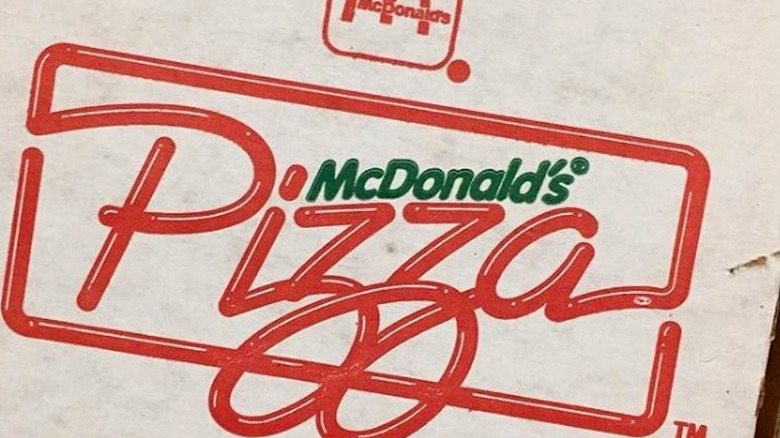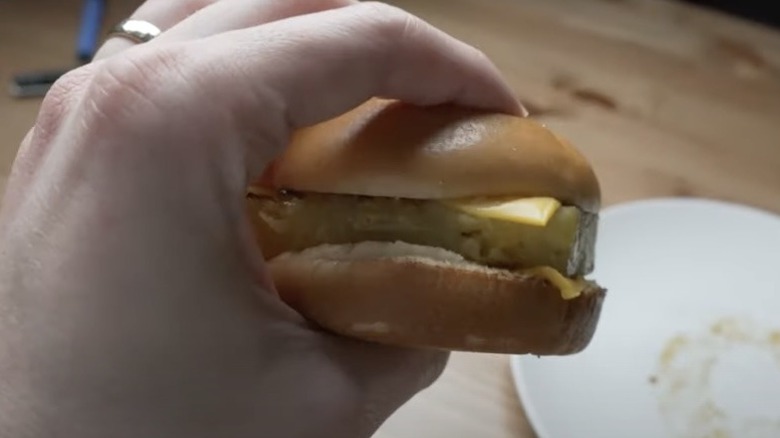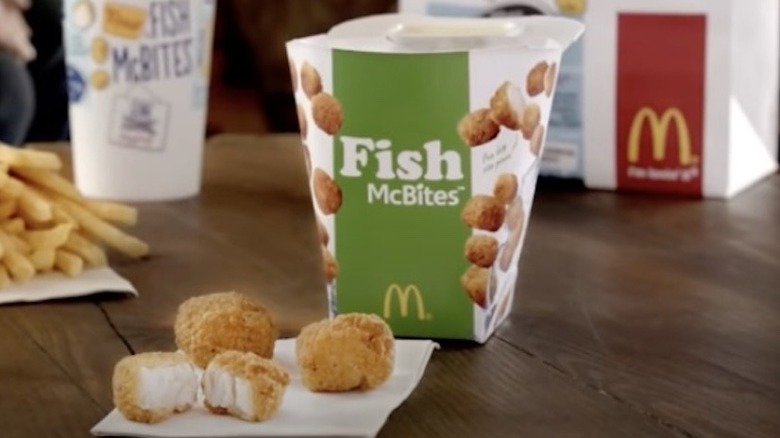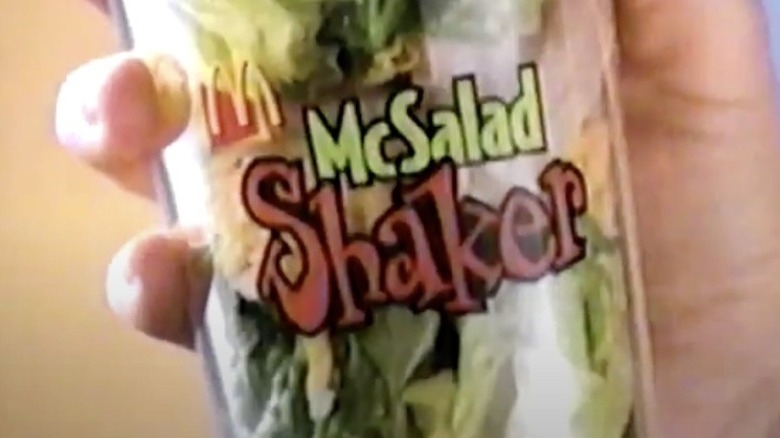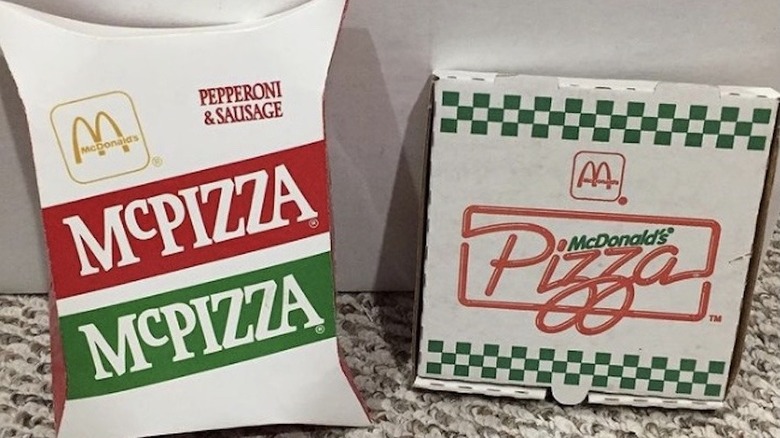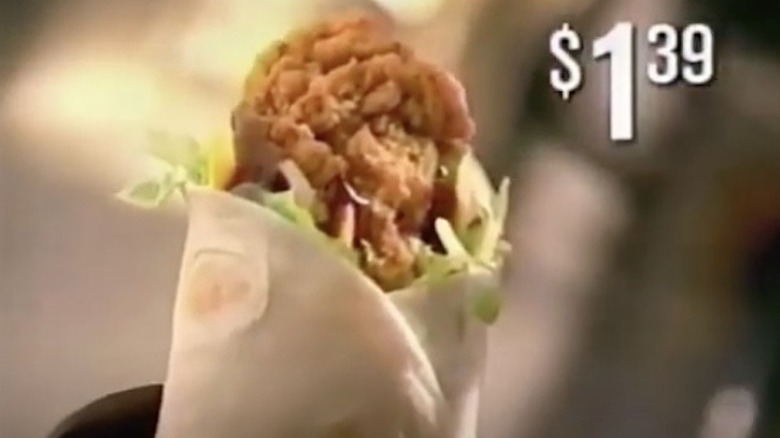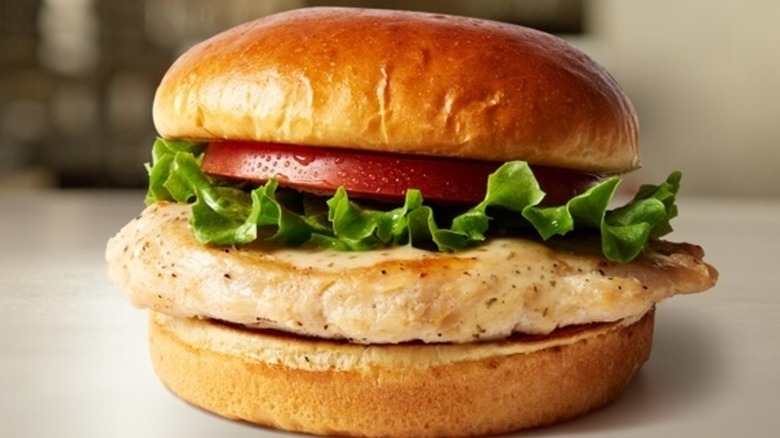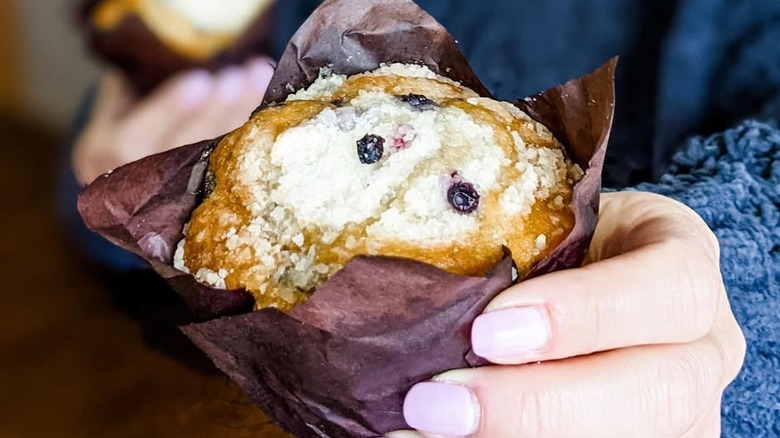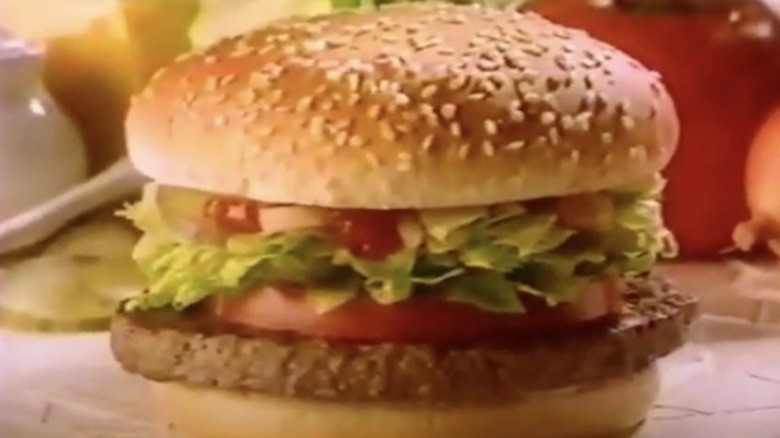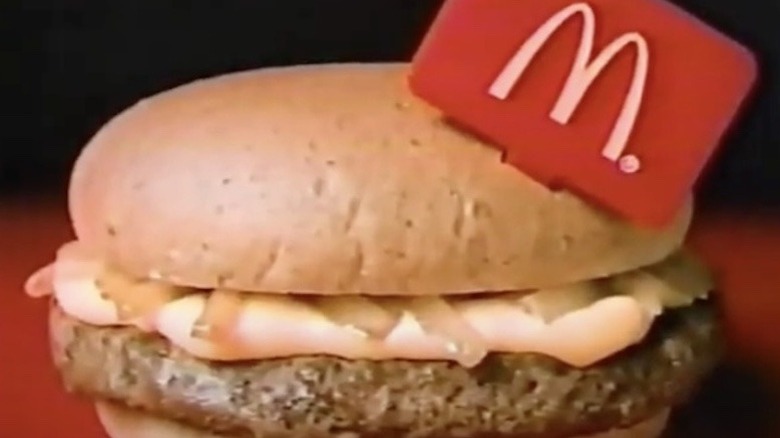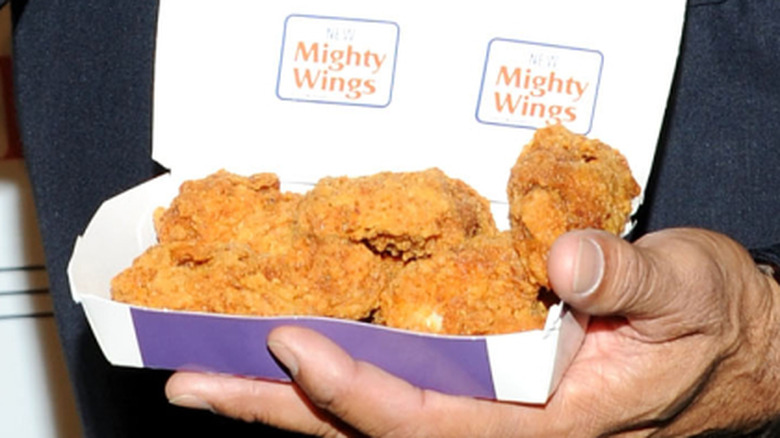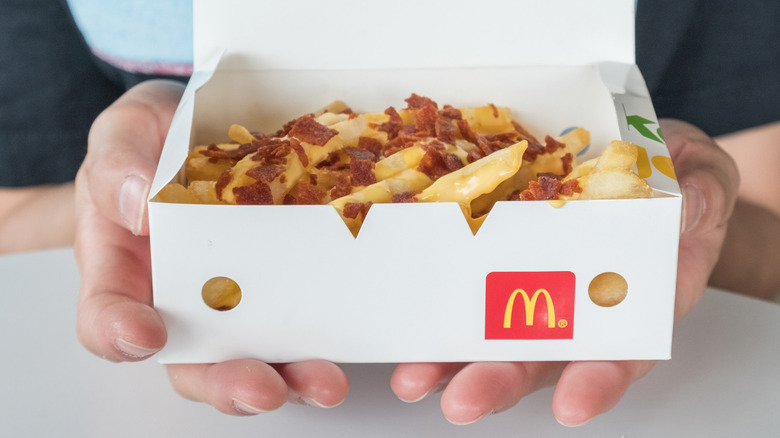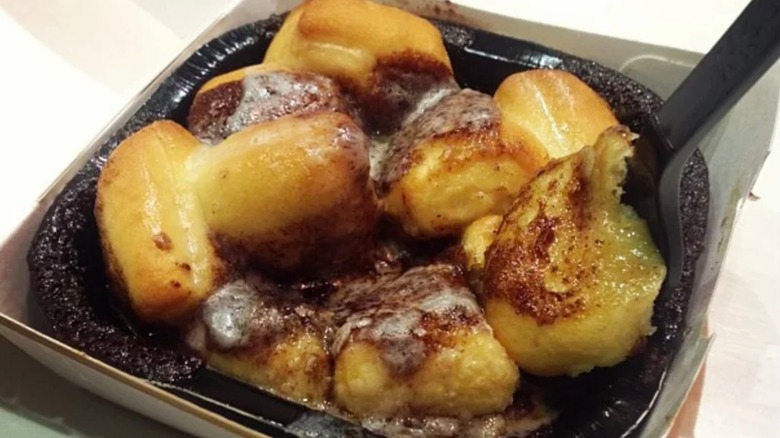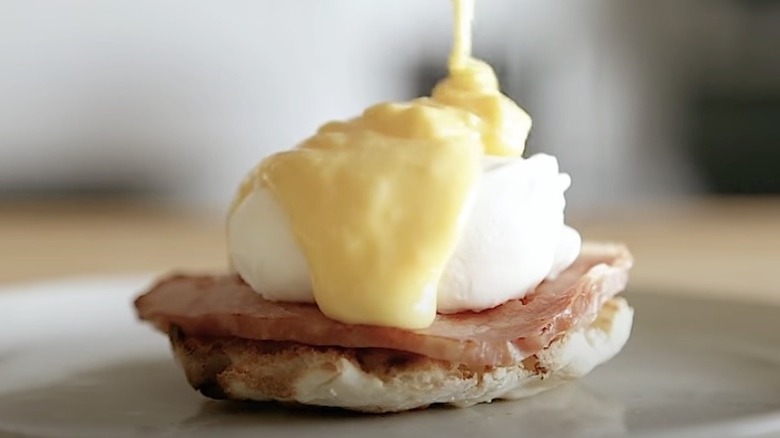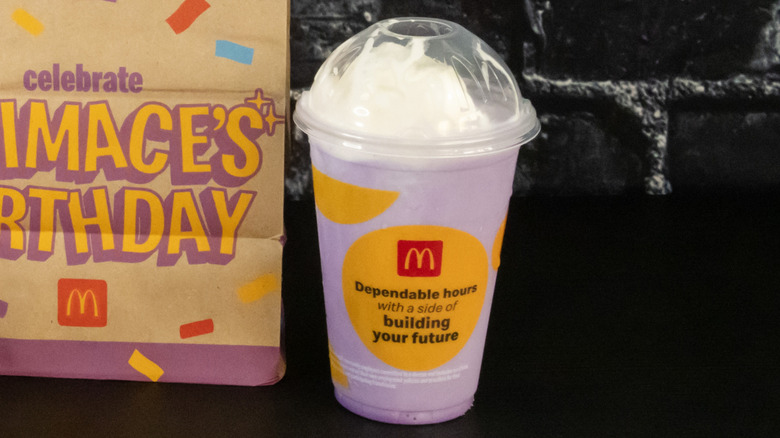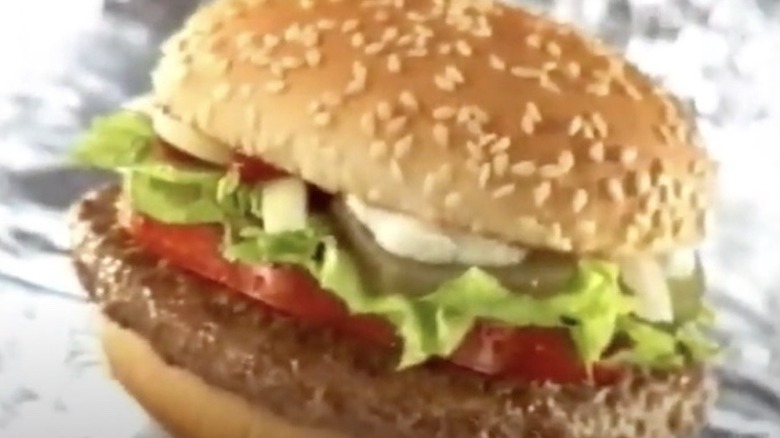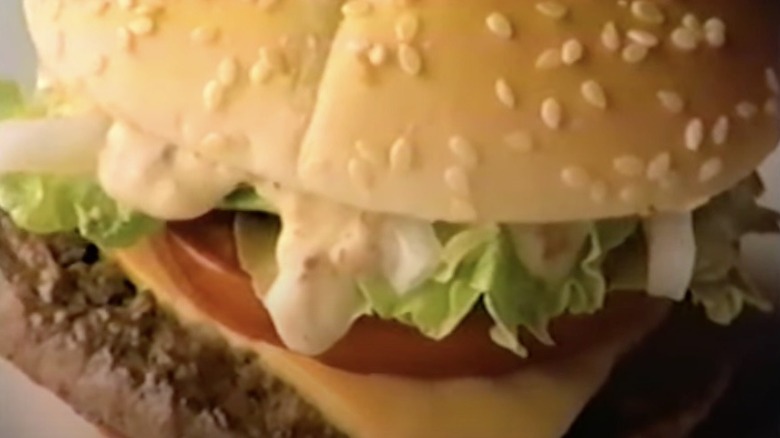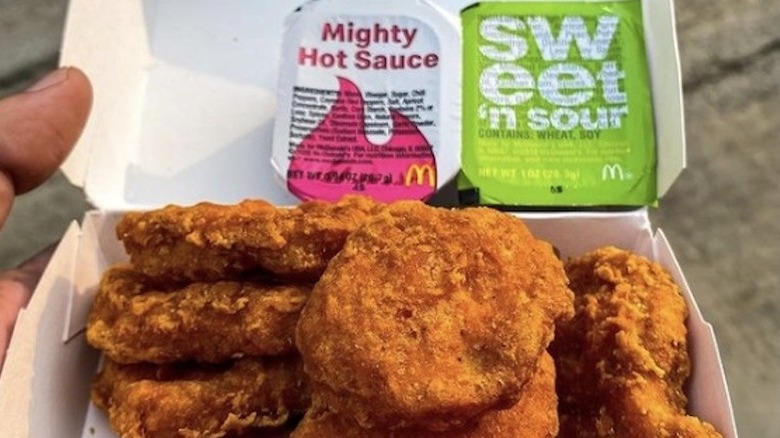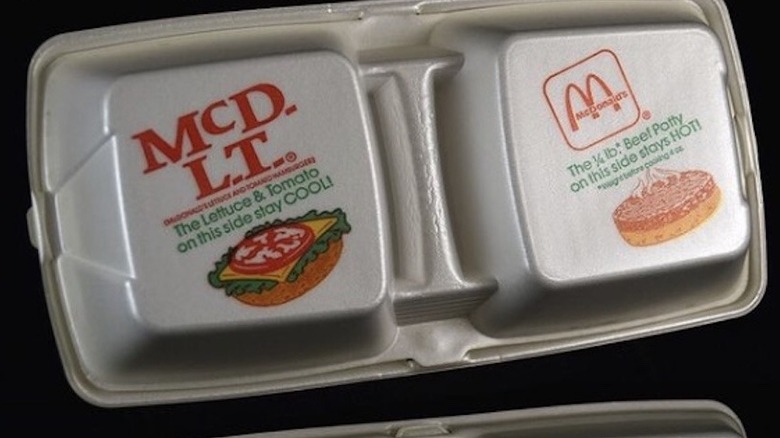18 Popular Discontinued McDonald's Items Ranked Worst To Best
McDonald's is by far the most popular fast food restaurant in America, having served "billions and billions" as its signs declare. McDonald's is still easier to find than its competitors, with more than 13,000 locations in the United States alone. McDonald's became so popular by selling a consistent product, but this isn't to say that McDonald's doesn't innovate. Over the decades, it's greatly expanded its original menu of hamburger, cheeseburger, fries, and shakes to include the Big Mac, Chicken McNuggets, breakfast sandwiches, sweet coffee, and ice cream treats, and the pork-based McRib, for example. Forever eager to create, discover, and capitalize on the next big thing in fast food, McDonald's aggressively tries out new items all the time.
But despite market testing and research pointing toward success, many of these new foods completely flop. Die-hard fans of those menu standouts never give up hope that a forgotten and long-discontinued foodstuff could return to the McDonald's big board one day. The only problem: Some disappeared McDonald's sandwiches, sides, and entrees are much better than others. Here are some of the most and fondly remembered McDonald's failures ranked from least-missed to most-missed.
18. The Hula Burger
In the mid-20th century, one of the largest meat-eschewing groups in America were adherents of the Roman Catholic faith, who, as part of the reflective 40-day period of Lent each year, avoid meat on Fridays. That led to a huge drop in business on Fridays for a McDonald's franchise in a predominantly Catholic part of Cincinnati owned and operated by Lou Groen. In order to help keep revenue up, he petitioned McDonald's corporate office to introduce a Catholic-friendly option. Since fish was allowed on Fridays, he suggested a fried whitefish patty on a bun.
McDonald's boss Ray Kroc was put off by the sandwich's relatively complex prep process and gave Groen his own idea for a meat-free item — the Hula Burger. It consisted of a slice of grilled pineapple, topped with cheese, and placed on a bun. And that was all. So convinced was Kroc that the Hula Burger was a sure thing that he set up a test at Groen's McDonald's. Both the Hula Burger and the newly created Filet-O-Fish would be offered on a Friday, and whichever sold more would be permanently added to the McDonald's national menu. By the end of the day, 350 Filet-O-Fish sandwiches were ordered, compared to only six Hula Burgers, which probably makes it the least popular fast food item in history. And with good reason — it was simple, bland, and not very well thought out.
17. Fish McBites
It's hard to figure out why some fast food menu items even exist at all. Take McDonald's Fish McBites for example, an ill-fated attempt to re-create the world-altering success of the Chicken McNugget but with fried fish, a polarizing choice even at Mickey D's. It's a specialty item that only sells particularly well during Lent, when Catholics skip meat in favor of fish, so McDonald's didn't really need to create a spinoff.
In February 2013, around the time of the 50th anniversary of the Filet-O-Fish (and just before Lent), McDonald's introduced Fish McBites, responding to research that parents wanted more fish options in kids' meals. Made of the same Alaskan pollock as the Filet-O-Fish, the McBites were more convenient than a fish sandwich, but not that much more convenient than, say, going home and heating up some fish sticks — because that's what this item really was, just gussied up with some dipping sauce. Fish McBites quickly went belly up, and anyone who misses them can simply order a Filet-O-Fish and get pretty much the same taste experience.
16. McSalad Shakers
Maybe McDonald's was responding to the perceived demand for healthier options on its menu, or perhaps the chain wanted to pull in a demographic that didn't usually hit up a burger joint for lunch. Whatever the case, McSalad Shakers were a poorly and cynically devised item that McDonald's thought so little of that it made buyers perform the food construction themselves and tried to pass that off like it was fun.
Introduced in three varieties in the early 2000s, a McSalad Shaker kit consisted of a domed, clear plastic milkshake cup that was filled with flavorless romaine lettuce (similar to the pre-cut, pre-washed bag kind sold in supermarkets) along with toppings. The Chicken Caesar McSalad came with sliced chicken and shredded cheese, while the Garden McSalad included a cheese blend, tomatoes, green onions, and a chopped boiled egg. The dressing packet — gloopy, mass-produced, overly sweet, and, ironically, not particularly healthy stuff — came separately. And here's where the fun part came in. Eaters squirted dressing into their McSalad Shaker cup, put the lid on, and then agitated it wildly to spread the dressing. And then they got to eat an extremely mediocre salad out of a cup, through a narrow opening.
15. McPizza
Pizza has been around for decades, of course, but it had an especially explosive cultural moment in the 1980s, with chains like Pizza Hut, Domino's, and Papa John's expanding and heavily competing with one another. McDonald's considered the entire pizza business a threat to its foundational business of burgers and fries, so in 1986, per Mental Floss, it took a "if you can't beat them, join them" approach, and started to roll out pizza in hundreds of its stores.
However, pizza and McDonald's proved fundamentally mismatched. McDonald's customers were used to waiting just a minute or two for their food, while McPizza could take 10 or more minutes to arrive, because that's how long it takes to properly cook a pizza. The preparation took up a lot of labor and kitchen space, too, and all to serve a savory pie that wasn't nearly as good as one from a pizza parlor, where the recipes and technique had been greatly honed over time. The taste, texture, and quality of McPizza fell somewhere in between that of a pre-frozen, quick-baked Totino's Party Pizza and a Pizza Hut personal pan pizza purchased at a kiosk inside of a Target.
14. McWrap
To borrow a catchphrase from a non-burger-oriented fast food giant, sometimes a company has to "think outside the bun." McDonald's did just that in 2006 when, according to Fast Food News, it unveiled its first Snack Wrap. Priced exceptionally cheap at just over $1, the item — which was the result of extensive test marketing — felt like something thrown together by a hungry, latchkey kid or college student with not a lot of food in the house. It was a small flour tortilla wrapped around a chicken strip with some shredded cheddar cheese and lettuce, and ranch dressing. Within a year, per The Impulsive Buy, more Snack Wraps appeared on the scene, including the Honey Mustard Snack Wrap, the Chipotle BBQ Snack Wrap, and the Salsa Roja Snack Wrap. They were a lot like the original, but with the ranch subbed out for different, ordinary condiments soaked into that same old chicken piece.
According to Delish, McDonald's started to phase out its wraps line in 2016, and they were gone by 2019, per Investopedia. The reason: The steam-cooking of tortillas added so much time to the prep process that it backed up drive-thru lines, which subsequently hurt revenues. Despite popular online petitions, the Snack Wrap remains out of American McDonald's, but really, fans could make one themselves at home with a tortilla, frozen chicken strip, and whatever salad dressing they've got laying around.
13. Artisan Grilled Chicken Sandwich
At any given time, McDonald's seems to offer multiple takes on the standard fast food chicken sandwich, varying up the breading style and condiments to create wholly new items. In 2015, McDonald's debuted a sandwich made from a non-breaded fillet touted as a good choice for health conscious customers. The Artisan Grilled Chicken Sandwich was built around a grill-seared, actual breast of chicken flavored with common spices and a blend of oils and made without chemicals like sodium phosphates. The protein sat, along with leafed lettuce and a big tomato slice, inside of a halved artisan roll.
In June 2020, facing coronavirus-era challenges with regards to supply and labor, as well as shifting customer tastes, McDonald's eliminated several items from its national menu. "To simplify operations in our kitchens and for our crew, and ensure the best possible experience for our customers, we are working with our franchisees and local restaurants to focus on serving our most popular choices," McDonald's senior vice president Bill Garrett told Business Insider. Among the items culled: the Artisan Grilled Chicken Sandwich. While McDonald's said that the cuts would be temporary, the Artisan Grilled Chicken Sandwich, not an overwhelmingly huge seller during its five years on the menu, never returned.
12. McCafe Bakery
In the 2020s, McDonald's aggressively expanded its morning menu, looking to dethrone Starbucks as the ruler of the coffee and pastry market. With its McCafe brand, McDonald's began selling high-end coffee blends and installed espresso machines to make lattes, mochas, and other premium coffee drinks. And because pastries pair well with coffee, both at Starbucks and in general, McDonald's launched a line of baked goods under the McCafe banner in October 2020. All three entries were classic, familiar, straightforward options: a blueberry muffin, a cinnamon roll, and an iced apple fritter.
Just under three years later, McDonald's announced that it would get rid of the whole McCafe Bakery line in the United States, doing away with the muffin, cinnamon roll, and doughnut options. "We're always listening to our fans and adjusting our menu based on what they crave," McDonald's said in a statement (via NBC's "Today"). With those sweets disappearing by July 2023, the only treats left available on the McDonald's menu were cookies and baked pies. While McDonald's strongly implied that the simple baked goods, similar to those that can be found in most any bakery, grocery store, or Starbucks across the country, weren't selling well, some fans were upset. "Every time I find something I love, companies discontinue. Ugh!" wrote one fan on Instagram, while another added, "I'm so upset, I really loved the blueberry muffin."
11. McLean Deluxe
Even a carefully made, high quality imitation is going to feel like an imitation — the re-creation almost inevitably lacks an intangible specialness of the original. Impossible Burgers taste almost like real beef patties, for example, and the McLean Deluxe, a highly touted, early '90s McDonald's offering, tasted almost, but not quite, like a McDonald's Quarter Pounder, which, frankly, was unnerving.
Capitalizing on the "low-fat" and "lite" craze that defined the manufactured food world in the late 1980s and early 1990s, the McLean Deluxe appeared on McDonald's menu in 1991, promising to contain all the familiar taste of a famous McDonald's burger just with a significant reduction in calories and fat. (It's sort of like how frozen yogurt peddlers claimed their product tasted just like ice cream — it didn't, but it would certainly suffice as a way to enjoy treats while attempting to adhere to a more calorie-conscious eating plan.) Alongside lettuce and tomato on a bun, the star of the McLean was a beef patty which McDonald's claimed was 91% fat-free. With 10 grams of fat — about a third of what a Quarter Pounder with Cheese packs — McDonald's literally filled in the holes where the fat had been removed with water and a seaweed derivative that binds meat together, according to the Chicago Tribune. The sandwich didn't taste like seaweed mixed with beef, but it did lack the smooth mouthfeel of a regular McDonald's burger, which might be why it never caught on.
10. Cheddar Melt
In 1988, McDonald's tried to get just a little bit fancy, introducing a sandwich that looked much like one of its regular cheeseburgers, but prepared a little bit differently and with slightly more upscale ingredients. Behold, the short-lived McDonald's Cheddar Melt. Instead of a plain white bun, McDonald's used a wheat bun — exotic for fast food in the late 1980s. Out went the slice of processed American cheese, and in came a hefty spoonful of creamy, gooey cheese sauce, not unlike that found on Welsh rarebit. And for a little kick, there were some onions, too, but not diced raw ones as per usual, but grilled, caramelized ones. All those little changes added up to a cheeseburger that felt more elevated than standard McDonald's grub, or even the diner-style melts that inspired the Cheddar Melt. It was a flavorful, mildly provocative spin on the regular McDonald's menu, but one step too far into the unknown to prove successful for the company in the 1980s.
9. Mighty Wings
Mighty Wings rank as one of McDonald's most disastrous and most public failures. Introduced to thousands of stores in the chain in September 2013, according to Bloomberg, they sold so poorly that just six months later, McDonald's more or less admitted defeat by deeply discounting the price of the item by 40 percent — it's not often a fast food chain has a clearance sale, they generally just drop an unpopular item to save face.
And yet, the spectacular demise of Mighty Wings completely overshadowed the product itself. Taste-wise, Mighty Wings were, well, just fine. Could they compete with McDonald's iconic, extremely culturally entrenched Chicken McNuggets? No, but they were pretty tasty in their own right. Mighty Wings were liberally breaded, extra-large bone-in chicken segments that could almost measure up to a KFC drumstick on both those criteria, and very pleasantly crispy to boot. Owing to the relatively high cost of chicken in its non-nugget form and the financial loss McDonald's suffered, Mighty Wings will likely never return to the Golden Arches.
8. Cheesy Bacon Fries
The ridiculous amount of fries McDonald's sells every day makes it far and away the chain's bestselling menu item, also the top ranked french fries in fast food, according to customers. In 2019, McDonald's restaurants in the U.S. attempted to make a good thing even better, taking a cue from sit-down restaurants and pubs and added cheese and bacon. Already a long-standing menu item in Australia, and after a successful test launch, Cheesy Bacon Fries went national, pitched as "a regional limited-time-offer menu item," the company claimed, according to Nation's Restaurant News.
Available on its own, or as a customization to the fries in an Extra Value Meal, Cheesy Bacon Fries were just that: cheese sauce and a generous portion of applewood bacon bits dropped onto a tray of beloved McDonald's french fries. While initially up for grabs in the first quarter of 2019, Cheesy Bacon Fries were so robustly accepted by McDonald's customers that the chain brought them back for the summer of that same year. And then, shortly after, they disappeared again.
7. Cinnamelts
McDonald's tried to capture the Cinnabon magic in 2007 with the debut of Cinnamelts, a dense, sugary monument of sweetness served as part of the chain's breakfast and dessert menus. At a tough to beat, ultra-low initial price point of $1.59, the Cinnamelts were like four cinnamon rolls in one, designed to break away into four sections of tender pastry dough covered in a paste made of cinnamon and sugar and all of it drenched in sticky frosting.
The Cinnamelts remained a steadfast entry on the all-day McDonald's menu for nearly a decade, until the chain abruptly and without a stated reason decided to stop selling them in 2016. "Our Cinnamon Melts are sorely missed, but we're sure you'll find a new breakfast sweet with the new desserts coming soon," a McDonald's account declared on X, formerly known as Twitter. The death of Cinnamelts has inspired multiple online petitions that have unsuccessfully insisted on the reinstatement of the concoction. Nearly a decade after Cinnamelts went away, a return seems more and more unlikely.
6. Eggs Benedict McMuffin
The Egg McMuffin always kind of evoked Eggs Benedict anyway. That classic, elegant brunch dish consists of two halves of an English muffin topped with a poached egg, ham, and creamy, tangy Hollandaise sauce. The Egg McMuffin debuted at McDonald's in 1971 — the first time an American fast food giant sold a breakfast sandwich, or breakfast food at all, for that matter — and clearly took inspiration from the Benedict. It consists of an egg disc (which has a similar texture as a poached egg) topped with ham and placed between two English muffin halves — it's Eggs Benedict made portable, eatable without a knife and fork, and dropping the Hollandaise sauce.
Everything looped back around to itself in the summer of 2001 according to QSR Magazine, when McDonald's, in an inexplicable promotion tied to the release of Disney's "Atlantis: The Lost Empire," introduced the Eggs Benedict McMuffin. It was a garden variety McMuffin but with a small, not-too-messy amount of "special breakfast sauce" in the middle. The limited-time offering was everything great about a McMuffin — portability, numerous breakfast foods in every bite — but with the addition of the rich and tasty "breakfast sauce" that tasted a lot like Hollandaise. There was little to not like about the Eggs Benedict McMuffin, but McDonald's retired the product.
5. Grimace Birthday Shake
One of the most established characters of the since phased-out McDonaldland troupe of advertising mascots, Grimace was at first Evil Grimace, a monster that stole milkshakes. McDonald's rebooted the character into a friendly, purple thing, supposedly the living embodiment of a taste bud. In a nostalgia-based marketing move in June 2023, McDonald's celebrated the 52nd birthday of Grimace with the Grimace Birthday Meal. It came with either a Big Mac or 10 Chicken McNuggets, fries, and a Grimace Birthday Shake. "Inspired by Grimace's iconic color and sweetness," McDonald's said in a press release, the drinkable dessert consisted of vanilla soft-serve ice cream blended with a blueberry-flavored syrup.
That simple recipe resulted in a tasty, berries-and-cream flavored but very odd-looking shake that was nevertheless a massive hit, bolstered by the virality of Grimace Shake-based videos on TikTok. The shake disappeared from McDonald's as scheduled in July 2023, but returned in 2024 — in Canada, and in some international markets, but not in the United States, despite the extraordinary and unexpected popularity of the item.
4. The Big N' Tasty
The Big N' Tasty is maybe the most astonishingly simple named product in history. No bells, whistles, or evocative language here — the late 1990s-era McDonald's sandwich was indeed both large and flavorful. It was also a tactical move, designed to resemble and compete with Burger King's forever-popular Whopper, per the Associated Press — it consisted of a hefty portion of peppery beef, plus lettuce, tomato, cheese, pickles, ketchup, and plenty of mayonnaise.
The Big N' Tasty was also reminiscent of the popular but defunct 1980s McDonald's item, the McDLT, as it similarly piled the veggies high. Nor was the Big N' Tasty shy about the condiments, all of which converged to create a memorably delicious and sizable sandwich that felt like a true bargain when McDonald's would throw it onto its Dollar Menu . By 2011, the novelty had faded, however, and McDonald's discontinued the Big N' Tasty. But that hasn't stopped online petitioners from trying to get it reinstated.
3. Arch Deluxe
It's entirely possible that McDonald's was ahead of its time with the Arch Deluxe, and that the problem wasn't the sandwich but a world that wasn't ready for deluxe, high-end, specialty burgers from a fast food restaurant, let alone the most inoffensively reliable fast food restaurant. In 1996, years before the likes of Hardee's and Carl's Jr.'s Six-Dollar Burger, McDonald's introduced the large and premium Arch Deluxe, consisting of a well-seasoned patty on a bun and topped with lettuce, cheese, tomato, and ketchup, as well as more novel ingredients like a disc of bacon, sliced onions, and a big dollop of a peppery mayonnaise-based sauce.
It was tangy, resulted in a complex mouth-feel, and didn't taste like anything else on the McDonald's menu. The company prepared the world for that reaction with a $200 million marketing campaign, nicknaming it "the burger with the grown-up taste." As evidenced by the total failure of the Arch Deluxe, people in 1996 didn't want to go to McDonald's for something fancy that would challenge their palette. That sauce (along with the bacon) set it too far apart from the chain's regular fare, and if served today, at a sit-down spot like Chili's or Red Robin (or even at McDonald's) it would probably find an audience.
2. Spicy Chicken McNuggets
McDonald's introduced Chicken McNuggets in 1983, but it feels like they've been around forever. It completely changed the game on how chicken is processed and consumed in both fast food and frozen food sectors, and most every other major burger restaurant had to respond with their own hoped-for McNugget toppler. Burger King's Chicken Fries and Wendy's popular 99-cent nuggets have their fans, but the McNugget remained the industry standard in chicken until 2019, when a spicy chicken sandwich craze, started by Popeye's, prompted fast food titans to step up their fowl game. McDonald's played along, introducing the Spicy Chicken McNuggets in September 2020 for a limited time, then bringing them back for another short period in February 2021, according to USA Today.
The upgrade was simple but effective — the Spicy Chicken McNuggets are breaded in the same tempura batter as their milder predecessor with but cayenne and chili pepper added to the mix, and served alongside a kicking Mighty Hot Sauce. Somehow, McDonald's took something both near-perfect and beloved, the McNugget, and made it new again, and also wonderful. Here's hoping McDonald's makes these fiery gems a permanent menu item, and soon.
1. McDLT
While the idea of assembling food oneself seemed annoying and pointless when McDonald's encouraged the notion with its McSalad Shakers, it can be a fun and even necessary thing if the restaurant provides a legitimate reason for the activity. Such was the case for the mid-1980s cultural phenomenon of the McDLT. A large hamburger sandwich with a quarter-pound meat patty and lettuce, tomato, and mayonnaise, the meat stayed hot until the first bite, which also included surprisingly crisp and still-cold veggies — because the eater slapped the two halves of the sandwiches together just before tucking in.
Thanks to a memorable ad campaign starring future "Seinfeld" actor Jason Alexander leading a song-and-dance number explaining that with the McDLT, "the hot stays hot" and "the cool stays cool" because of McDonald's innovative packaging design. The McDLT arrived in a double-wide styrofoam box, with one covered spot for the hot side and a separate one for the cold side. The whole thing worked, making for a delicious sandwich with numerous temperatures, textures, and flavors all jockeying for position and blending nicely — which usually doesn't happen with everything-all-at-once fast food burgers.
McDonald's ultimately got rid of the sandwich because of the environmental impact. The 1980s is when the world realized that styrofoam was a landfill-filler that took years to break down, and rather than add to the world's trash heap, McDonald's heard environmental groups' pleading and got rid of the tasty sandwich whose quality relied heavily on its packaging.
